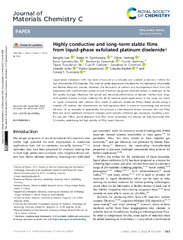Приказ основних података о документу
Highly conductive and long-term stable films from liquid-phase exfoliated platinum diselenide
| dc.creator | Lee, Kangho | |
| dc.creator | Szydłowska, Beata M. | |
| dc.creator | Hartwig, Oliver | |
| dc.creator | Synnatschke, Kevin | |
| dc.creator | Tywoniuk, Bartlomiej | |
| dc.creator | Hartman, Tomáš | |
| dc.creator | Tomašević-Ilić, Tijana | |
| dc.creator | Gabbett, Cian P. | |
| dc.creator | Coleman, Jonathan N. | |
| dc.creator | Sofer, Zdeněk | |
| dc.creator | Spasenović, Marko | |
| dc.creator | Backes, Claudia | |
| dc.date.accessioned | 2023-01-25T10:38:56Z | |
| dc.date.available | 2023-01-25T10:38:56Z | |
| dc.date.issued | 2022 | |
| dc.identifier.issn | 2050-7534 | |
| dc.identifier.issn | 2050-7526 | |
| dc.identifier.uri | https://cer.ihtm.bg.ac.rs/handle/123456789/5635 | |
| dc.description.abstract | Liquid-phase exfoliation (LPE) has been introduced as a versatile and scalable production method for two-dimensional (2D) materials. This method yields dispersions that allow for the fabrication of printable and flexible electronic devices. However, the fabrication of uniform and homogeneous films from LPE dispersions with a performance similar to that of bottom-up grown materials remains a challenge, as the film quality strongly influences the optical and electrical performance of devices. Furthermore, long-term stability remains a major challenge for all 2D material based applications. In this study, we report on highly conductive tiled network films made of platinum diselenide (PtSe2) flakes derived using a scalable LPE method. We characterized the homogeneous films in terms of morphology and electrical behavior. As an example of applicability, we produce a chemiresistive sensor structure with the PtSe2 films and show significant resistance changes upon periodic ammonia gas exposures, revealing a sub-0.1 part per million (ppm) detection limit (DL). More remarkably the devices are fully functional after 15 months, underlining the high stability of PtSe2 based devices. | sr |
| dc.language.iso | en | sr |
| dc.publisher | Great Britain : Royal Society of Chemistry | sr |
| dc.relation | info:eu-repo/grantAgreement/MESTD/inst-2020/200026/RS// | sr |
| dc.relation | info:eu-repo/grantAgreement/ScienceFundRS/Promis/6057070/RS// | sr |
| dc.relation | The European Union’s Horizon 2020 - grant agreement no. 881603 (Graphene Flagship Core 3) | sr |
| dc.relation | The German Federal Ministry for Education and Research (BMBF) under the project no 16ES1121 (NobleNEMS) | sr |
| dc.relation | The Czech Science Foundation (GACR No. 20-16124J) | sr |
| dc.rights | openAccess | sr |
| dc.rights.uri | https://creativecommons.org/licenses/by/4.0/ | |
| dc.source | Journal of Materials Chemistry C | sr |
| dc.subject | long-term stable films | sr |
| dc.subject | diselenide | sr |
| dc.subject | Platinum compounds | sr |
| dc.title | Highly conductive and long-term stable films from liquid-phase exfoliated platinum diselenide | sr |
| dc.type | article | sr |
| dc.rights.license | BY | sr |
| dc.citation.volume | 11 | |
| dc.citation.issue | 2 | |
| dc.citation.spage | 593 | |
| dc.citation.epage | 599 | |
| dc.citation.rank | M21~ | |
| dc.identifier.doi | 10.1039/d2tc03889g | |
| dc.identifier.fulltext | http://cer.ihtm.bg.ac.rs/bitstream/id/23621/d2tc03889g.pdf | |
| dc.identifier.scopus | 2-s2.0-85144808791 | |
| dc.identifier.wos | 000899135800001 | |
| dc.type.version | publishedVersion | sr |
Документи
Овај документ се појављује у следећим колекцијама
-
Radovi istraživača / Researchers' publications
-
Gramulsen
Graphene-Based Wearable Multiparameter Sensor


